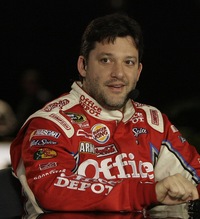TONY STEWART - A Breath Of Fresh Air At Phoenix
 |
KANNAPOLIS, Feb. 23, 2011: From the hallowed grounds of Daytona (Fla.) International Speedway to the foot of Monument Hill, which way back in 1864 was the geographical starting point for what became the State of Arizona in 1912, Tony Stewart and his NASCAR Sprint Cup Series brethren are oh-so-ready to settle into a bit of racing normalcy.
 |
The season-opening Speedweeks at Daytona may offer stock car’s ultimate prize in the form of the Daytona 500’s Harley J. Earl Trophy, but it’s also nine solid days and nights of full-throttle activity on and off the racetrack that makes three-day events such as this weekend’s Subway Fresh Fit 500k at Phoenix International Raceway a breath of fresh air.
For Stewart, driver of the No. 14 Office Depot/Mobil 1 Chevrolet Impala for Stewart-Haas Racing, every trip to the legendary facility west of Phoenix is a welcome part of the schedule. This one, however, comes for the first time on the heels of the Daytona 500 after being moved from the original April date it assumed when Phoenix was awarded a second event to go with its traditional November spot on the NASCAR calendar. And, it will be the last one before the track undergoes a $15 million facelift – including repaving and slightly reconfiguring its quirky mile oval – immediately following Sunday’s 312-lap race.
 |
The 47-year-old racetrack, with the 150-foot Monument Hill standing majestically to the east just outside turns three and four, will be repaved for the first time since 1990 and renovated for the first time since 2003, when the familiar Goodyear Bridge over turn four was replaced by an access tunnel. The new, high-tech racing surface will be variably banked in all four turns, as well as in its unique backstretch dogleg, and the dogleg will be moved outward 95 feet and will have its radius tightened from 800 to 500 feet. It’s all in the name of side-by-side racing, the kind sister track Homestead-Miami Speedway became known for after a similar repaving project.
Monument Hill, by the way, is a historic place by its own right that was designated by the U.S. Geological Survey as an anchor point for what was then the Territory of Arizona a full century before Phoenix International Raceway came to be. Located at the south side of the Gila River and the mouth of the Salt River, Monument Hill is surrounded by some of Arizona’s most fertile farmland, and it was declared the starting point for all Arizona survey efforts in 1864, as declared by a brass and aluminum marker at its summit. Today, its western slope is a popular viewing spot during race weekends.
Stewart’s history at the foot of Monument Hill is a rich one, as well. He was victorious at Phoenix during his rookie Sprint Cup season of 1999, and he has a win, seven top-fives, nine top-10s and has led a total of 327 laps in his 18 career Sprint Cup starts there. His average Sprint Cup finish at Phoenix is 12th, and he has a lap completion rate of 99.8 percent.
On top of all that, there is perhaps no driver who has logged more laps at Phoenix than Stewart. He’s competed at the mile oval in Sprint Cup cars, NASCAR Nationwide Series cars, Indy cars, Supermodifieds and USAC Midget and Silver Crown cars. Add up Stewart’s laps spent testing at the desert mile, and Stewart is in a league of his own.
So, after enduring the rigors of these most recent Speedweeks at Daytona, there’s nothing like hitting the familiar surroundings this weekend at stock car racing’s “Jewel of the Desert” in Arizona.
TONY STEWART, Driver of the No. 14 Office Depot/Mobil 1 Chevrolet Impala for Stewart-Haas Racing:
After spending so much time in Daytona for Speedweeks, how much of a relief is it to get back to a normal three-day race weekend?
“I think everybody’s pretty worn out after being in Daytona for so long. Phoenix means a normal routine and a chance for the crew guys to get back to their families for a couple of days before heading to another racetrack.”
Is too much emphasis placed on Daytona in terms of how teams are going to perform for the rest of the season?
“I think so. Daytona is a restrictor-plate race and, unlike Daytona, two guys can’t get in a line at Phoenix and go to the front. Daytona and Talladega (Ala.) have always just been two different forms of racing. With the draft being so important at those two tracks, it’s more of a team deal than an individual deal. What happens at Phoenix and the races after that has to be done on your own. You can’t help each other at Phoenix. You just have to go race.”
How long have you been racing at Phoenix?
“I started racing there in ’93 when I ran a USAC Silver Crown car. And since then, I’ve run USAC Midgets, Indy cars, Supermodifieds, Nationwide Series cars and, of course, Sprint Cup. So, I’ve logged a bunch of laps there. To think that it all kind of started at Phoenix, I guess you could say it’s the place where my career came full-circle.”
Did you take an immediate liking to Phoenix in 1993 when you ran there in USAC?
“When we ran the USAC cars out there, it was pretty cool because I had never gone that fast before. It’s just one of those tracks where, to run a Midget and a Silver Crown car there, it definitely got your attention. It was pretty fast.”
Did you get a pretty good paycheck that day?
“At that time, yeah, absolutely. When I was thinking about the $5 hours I was working at a machine shop, $3,500 was a pretty good payday.”
Is it safe to say you have Phoenix figured out?
“I’ve definitely spent a lot of time there. Myself and Arie Luyendyk were the two lead test drivers for Firestone when we were in the IndyCar Series. We spent a lot of time in Phoenix because the weather is so good out there all year long. We would spend three days out there tire testing and we had two or three of those sessions through the winter. I got to spend a lot of time running around Phoenix. I probably know every line around the track that’s ever been run and why it’s been run. It helps when you get in the stock cars or anything you get in when you’re out there. I pretty much know how to get around there.”
How did you transition from one type of racing to another?
“It’s more fear than anything that I’m going to have to get a real job if I’m not successful. That’s the great thing about running USAC and being in Indiana, where not only did we have winged Sprint cars and non-winged Sprint cars, Midgets, Silver Crown cars, we ran on dirt tracks one night and pavement the next. We ran Modifieds and Late Models. There were just so many things to drive around there that you learned how to adapt, and you learned how not to have a preconceived notion about how a racecar is supposed to feel and drive. You learned to read what the car was telling you as far as what it liked and disliked, and learned how to change your driving style accordingly. Especially at Phoenix, every car we’ve driven there, even though the track’s the same, they all drove differently. You just had to adapt to it and learn to read the racecar instead of thinking this is what the car I ran last night felt like and it’s supposed to feel like this today. It doesn’t work that way.”
Can you explain how Phoenix differs in the way the car handles in turns one and two as opposed to turns three and four?
“Every type of car I’ve driven there – from USAC Midgets and Silver Crown cars to Supermodifieds to Indy cars to Nationwide cars and now the Sprint Cup cars – running all those different divisions, the one common variable is the two ends of the track are unique and different from each other. It’s always been a situation where, if your car is really good in (turns) three and four, you’re normally a little bit tight in (turns) one and two, and if you get one and two really good, you’re normally a little bit too loose in three and four. You do have to weigh the options and try to find that balance of which end of the track is more important to you. You know you’re not going to be perfect in both ends, and you’ll have to pick one end or the other to get your car really good. I do have a preference, but I don’t tell everybody else that. That’s what having all these years and these laps of experience there does for me. It’s the one secret variable that I try to use to my advantage.”
When you return to Phoenix in November, it will be a very different racetrack – new pavement and an altered layout. What do you think of the changes?
“If it makes the racing better for everybody, then it’s a positive thing. But, I’m an old-school guy. I didn’t like it when they changed the dogleg. I hated it when they took the Goodyear bridge down – the cross-over bridge over turn four. Those were things about Phoenix that made it unique and made it special. That side has already been changed. Changes now really aren’t going to be different. It’s already lost its original look, to me, but if it makes it better and it makes it better for the fans, how can you not be excited about it?”
Since you have logged so many laps at Phoenix, did track management seek your opinion on the changes?
“No. Like I said, I’m still not happy about the original changes that were made. I’ve always just been that old-school guy and a lot of people in society are the same way. A lot of people don’t like change. You see places we’ve lost. We’ve lost Rockingham, (North) Wilkesboro, some of those places. As competitors, we didn’t like those changes, but it was better for the sport. Just because it’s different doesn’t mean it’s always going to be better or worse. We just have to wait and see. At least they’re trying to do something they think is going to be better for the sport.”